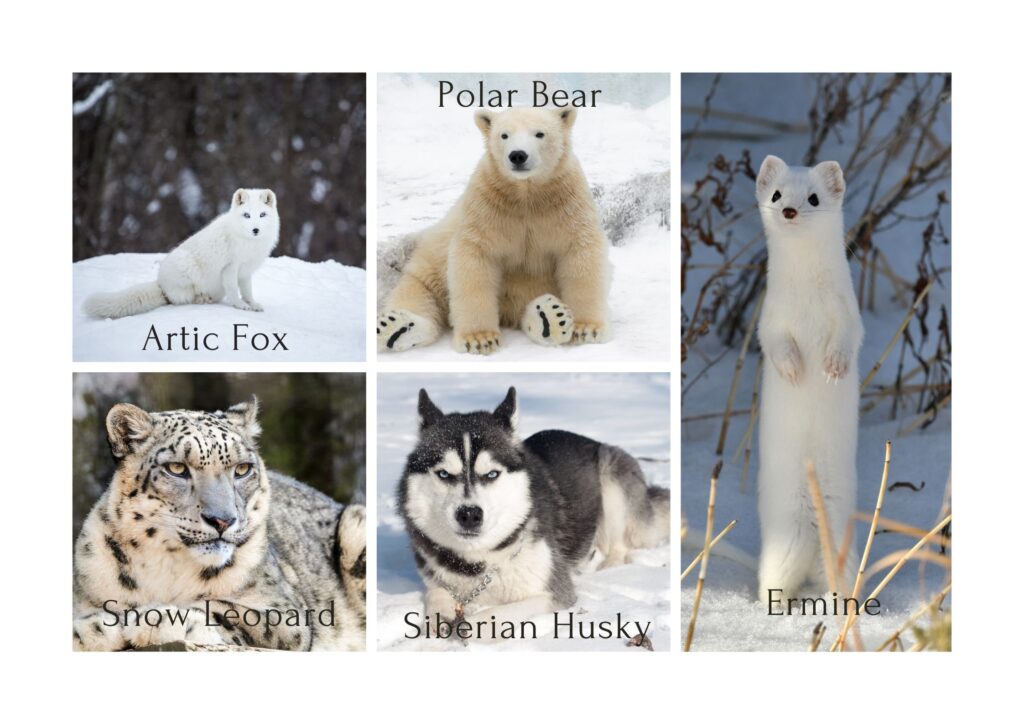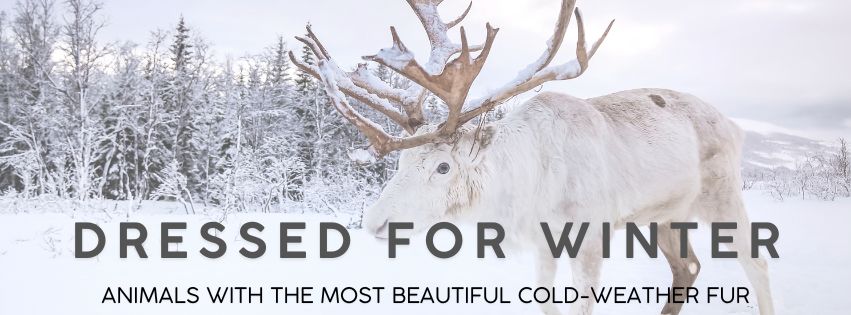Humans wear protective gears in winters but few animals are blessed with “Cold Weather Fur” which help them survive in harsh and difficult environment of polar regions.
As the chill of winter blankets the earth, nature unveils some of its most stunning masterpieces. Humans bundle up in wool and down, but many animals come naturally prepared for the cold. Their fur not only keeps them warm but also showcases incredible beauty. From shimmering snowy coats to patterns that blend perfectly with icy landscapes, these winter outfits are both stunning and practical.
Some animals have the most stunning cold weather fur, designed for survival yet effortlessly elegant. Their coats protect them, but they also radiate charm and grace. From the pure white pelt of the Arctic fox to the regal spots of the snow leopard, these creatures embody the true beauty of winter.
Want to know how living in cold environment is challenging, read –
The Fluffiest and Toughest : Animals with Incredible Cold Weather Fur
In this blog let’s perceive some fascinating creatures bearing cold weather fur and how they adapt to extreme weather conditions..
1. Arctic Fox: Nature’s Winter Chameleon
Artic fox is one of the marvelous mammal thriving in icy tundra where temperature can drop down to -50°C (-58°F). They are smaller in size but their extraordinary adaptations enable them to survive in extreme conditions. Its known as “Winter Chameleon” as its coat color changes seasonally to match with tundra region. These characteristic include –
– Double layered coat which has thick undercoat for insulation and longer outer coat to repel wind and moisture
– White winter coat helps camouflaging as well as reflect sunlight to retain heat.
– Their short legs, ears and muzzle(nose and mouth) reduce surface area exposed to cold.
– It’s fluffy bushy tail acts as blanket when it wraps around body and face.
– Fur covered footpads provide insulation as well as wide paws prevent sinking in snow.
2. Snow Leopard: The Mountain Ghost
The snow leopard is known as the “Ghost of the Mountains” for a reason. Its elusive nature helps it stay hidden in harsh, rocky landscapes. One of its greatest assets is its thick, luxurious fur. This dense coat allows it to survive in the freezing mountains of Central and South Asia, where temperatures can drop below -30°C (-22°F).
Their specialized fury features include –
– Double layered coat which has dense, woolly traps heat keeping the warm while outer layer has long, coarse hairs repel snow or frost keeping inner layer moisture free.
– Beautifully patterned coat has pale base coat which helps in blending in snowy landscapes while rosette-shaped spots make markings which merge them between rocks and snow making them nearly invisible to prey as well as predators.
– Their seasonal change in density of coat in winter i.e., the fur grows and becomes thick insulating in colder months.

3. Ermine: The Royal Winter Coat
Ermine’s winter coat has great historical significance being highly prized in medieval Europe symbolizing it for purity and wealth thus used by kings, queens and royal officials in their robes hence commonly known as “The Royal Winter Coat”. The unique characteristics include –
– Ermine’s fur is lightweight and streamlined supporting its agility and speedy activities, this conserves energy which is vital during food scarce winters.
– Coat changes color seasonally, its white fur helping it blend seamlessly with snowy landscapes, as this mammal is highly active in winter’s thus protecting it from foxes and owls also supports approaching prey undetected.
– Its dual-layered coat provides essential protection. The inner layer insulates, while the outer layer shields against wind and moisture. Combined with a high metabolism, this keeps the animal warm and energetic, even in the coldest environments.
4. Polar Bear: Arctic Majesty
The polar bear is an iconic Arctic species, built to survive extreme conditions. It thrives in some of the coldest places on Earth. Its thick fur keeps it warm even at -40°C (-40°F). The white coat helps it blend into the snowy landscape. Amazingly, its fur also dries quickly after swimming in icy waters.
This magnificent creature dominates icy habitat with unique characteristic as follow –
– Like other animals with winter coat they too bear dual layer viz., soft insulating under coat and long coarse hairy outer coat protecting from wind, snow and moisture.
– It’s unique fur makes it’s supreme ruler of snow which is transparent fur. This hollow har scatter light that gives it the white appearance which help them blending in the white landscape.
– The other key feature of the outer fur is its nature to dry quickly the polar bear has to just shake off excess water and they are ready to go reducing heat loss helping them stay warm even after swimming in icy waters.
– They have thick fat layers beneath skin called blubber that provides insulation, but the skin is black below fur which help in trapping heat from sunlight further enhancing the insulation and keeping them warm in the extreme cold and moist conditions.
– Their coat is maintenance free, they just roll over the ice or rinse in water after feeding to remove any debris or blood which can affect the hairs insulating properties.
5. Siberian Husky: The Winter Workhorse
Though domesticated, the Siberian Husky’s thick double coat is a masterpiece of adaptation. The Siberian Husky breed is renowned for its stamina, strength, and striking appearance, making it perfectly suited to thrive in cold, snowy environments. Its thick, double-layered coat is not only beautiful but also serves as an essential survival tool, enabling this breed to work and live comfortably in temperatures as low as -50°C (-58°F).
Their distinctive characteristic which help them excel in frigid conditions include –
– Like other snowy animals, they have a double coat for protection. However, their outer guard hairs have a unique feature. They reflect sunlight, preventing the Husky from absorbing too much heat. This makes them adaptable to moderate climates, despite their Arctic origins.
– They have thick fur providing insulation as well promote ventilation, this prevents overheating during activity or in slightly warmer environments. This supports their survival in snowy regions as well as urban life with their owners. This feature also serves as added advantage for their tirelessly sledding to transport goods, people and supplies enhancing their endurance in snowy environments.
– Their outer layer is water repellant and dries quickly further reducing the risk of hypothermia.
– As they have their links in Arctic which make them vulnerable to frostbites but their peculiar modification like pointed ears covered with thick fur reduce the chances of chilliness.
– Their bushy tail when wrapped around the face provides addition insulating layer as it serves as warm wooly scarf when they sleep.
There are other facts associated with frozen land, read more –
Wrapped in Warmth, Designed for Survival
These are only some of the astonishing animals with breathtaking winter coats. Our journey through these amazing animals shows that fur is more than just protection from the cold—it’s a masterpiece of evolution. Fur provides insulation, camouflage and functions by tailoring to each animal’s habitat. These adaptations allow them to not only endure, but thrive in an environment that would be challenging for most life forms.
Beyond their practical purposes, these fur coats remind us of the remarkable diversity and beauty found in the natural world. These winter coats amaze us, but they also remind us of a bigger responsibility. Protecting these animals means preserving their fragile habitats, which face constant threats from climate change and human activity. Preserving them ensures that future generations can continue to appreciate and adore nature’s amazing designs. So let’s do our part to protect them and their habitats, so their stunning coats and inspiring adaptations can continue to amaze us for years to come.
“Preservation is the sincerest form of admiration for beauty.”

Leave a Reply